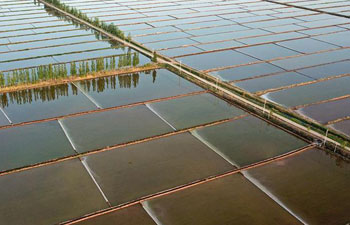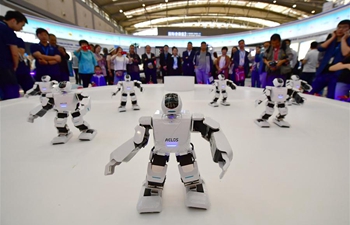CHICAGO, May 15 (Xinhua) -- By optimizing many parts of the carbon-recycling system, researchers at the University of Illinois (UI) can now drive two-electron chemical reactions, a substantial advance over one-electron reactions.
The results of the study, posted on UI website Tuesday, will aid those hoping to find a way to convert excess carbon dioxide in the atmosphere into useful energy sources, said UI chemistry professor Prashant Jain, who led the new research.
Instead of relying on biodegradable plant pigments to convert light energy into chemical energy, the researchers are turning to something better: electron-rich metal catalysts like gold, which at specific light intensities and wavelengths can transfer photoexcited electrons and protons to reactants without being degraded or used up.
"In our study, we used spherical gold particles that are 13 to 14 nanometers in size," Jain said.
When coated with a polymer and suspended in water, for example, the nanoparticles absorb green light and reflect a deep red color. Under light excitation, the nanoparticles transfer electrons to probe molecules, which then change color, allowing researchers to measure how efficiently the electron-transfer reactions are taking place.
By varying the intensity of laser light used in the experiments, the researchers discovered that at four to five times the intensity of solar energy, the gold nanoparticles in the system could transfer up to two electrons at a time from ethanol to an electron-hungry probe.
Two-electron reactions are far preferable to one-electron reactions, Jain said.
Jain also concluded that recent experiments using the same system also entailed multielectron, multiproton transfers. In the experiments, he and his colleagues converted CO2 to ethane, a two-carbon compound that is more energy-rich than methane, which contains only one carbon.
The researchers are hoping to eventually generate propane, which has a three-carbon backbone; and butane, which has four.
While the new findings will aid those hoping to find a way to convert excess carbon dioxide in the atmosphere into useful energy sources, much more work must be done before this technology is ready to be employed and scaled up to meet current challenges.
"There's still a long way to go. I think we'll need at least a decade to find practical CO2-sequestration, CO2-fixation, fuel-formation technologies that are economically feasible," Jain said.
The findings have been published in the journal Nature Chemistry.

















